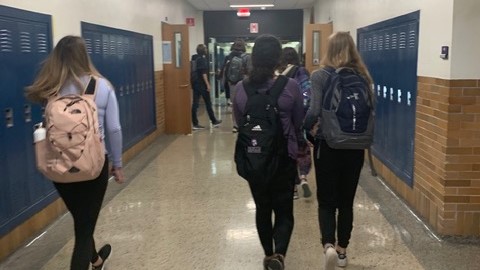Community recognizes both pros, cons to transition back to normalcy
April 24, 2021
With the considerable decline in COVID-19 outbreaks, hospitalizations, and deaths and more and more people getting vaccinated, society has inched its way to normalcy at a steady pace. As a result, District 99 has opened its doors to roughly twice as many students, and pre-pandemic vibes infuse the air. Still, students and staff maintain ambivalent views and note both pros and cons to this fresh chapter the world has begun.
Reduced Stress, Avoided Drawbacks & More
Senior Anika Oplanic has faced multiple struggles during her final year at DGN but feels the school’s return to in-person learning has significantly helped her deal with them.
“The stress of the final stretch for seniors [is] leading to a significant amount of burnout and senioritis for me personally,” Oplanic said. “[But] reverting back to in-person classes has been a refreshing experience. Being able to talk to my peers, teachers and friends on a daily basis in person outweighs the burnout of class.”
Counselor Katelyn Pantke believes the return to normalcy has allowed people to escape distance learning’s disadvantages and suggested that the disconnection the remote setting has caused is avoided through the transition back to in-person learning.
“I have so many students who were remote all year. While some thrived, many struggled. They struggled to stay connected and engaged. They lost motivation and got distracted easily at home, especially students whose parents were working too,” Pantke said.
Some, like math teacher Joann Purcell, believe that the shift back to in-person learning is the most ideal for everyone, saying the standard form of schooling can leave students better equipped for their futures.
“There are some students who have not been quarantining for quite some time [and] have been [around] friends. Those students are in a much better place mentally than those students who have families that have followed a strict quarantine,” Purcell said. “There is a very small percentage of students for whom remote learning is truly a better option. Almost all students will be better prepared for life by being in person.”
Social worker Brian Kittinger maintains similar views to Purcell’s in that the return of in-person learning can benefit all students. In addition, he anticipates that by beginning to be together once again, the DGN community can help each other heal from the past year’s difficult events.
“While we all have coped with the last year in many different ways, it [has been] a collective experience that we have all shared,” Kittinger said. “My hope is that as we come together, we can share those experiences, whether they be traumatic ones, ways [in] which we have grown and everything in between. When we realize that we’re not the only ones [who have] felt a certain way, it can help validate the way we [have] felt and help us learn.”
Guideline Concerns, Nervousness & Nostalgia
While multiple positives have come from the steady return to normalcy, some people have noted some of the potential drawbacks resulting from it.
According to counselor Mark Wasik, the new guidelines District 99 follows have caused feelings of unease in the DGN community and more students to learn remotely.
“Because students are now able to be within three feet of each other, if a student tests positive, students within six feet of that student for more than 15 minutes must quarantine,” Wasik said. “Consequently, I am seeing students and parents make the decision to learn remotely to avoid the risk of being exposed given the loosened distancing guidelines.”
Kittinger agreed that the return of in-person learning might lead to some worry and discomfort but noted that these factors might hurt students’ academic performance.
“I anticipate returning to full in-person learning in August and this being a time of high anxiety for a large number of students. I think nervousness and excitement are very normal feelings in these circumstances, but if it begins to keep us from meeting our daily expectations, such as coming to school [and] working in groups, it can have a real negative impact on our ability to grow and learn,” Kittinger said.
Oplanic referenced back to an aspect of remote learning and quarantine that she misses now that she has returned to in-person learning.
“I kind of miss the ironic freedom of social isolation. Last year, being separated from peer judgment led to a lot of people trying out new things without fear of being made fun of,” Oplanic said. “The overall attitude of the summer was ‘Just try it! No one’s going to see you anyway!’ I miss that. People didn’t care about what you wore, how your bangs turned out [or] what kind of eye makeup you tried—you were free from peer judgment.”
Words of Advice
Despite the pros and cons of and people’s mixed opinions about the shift back to normalcy, it seems many ultimately agree on one thing: such a transition must be done in a way that is safe and healthy for people’s mental, emotional and social well-being. Pantke proposed a way to make this happen.
“It has been a long and arduous year for everyone, some more than others and in different ways for all of us. Everyone needs to give themselves permission to acknowledge that and look forward to the future and the hope that is on the horizon,” Pantke said. “Take it slow. Take it one day at a time and remember to take deep breaths when you’re feeling overwhelmed. You’ve made it through this. You are strong and resilient and incredibly capable. Imagine what more you can and will do. You’ve got this.”
